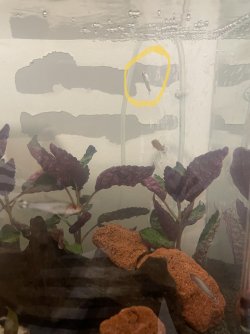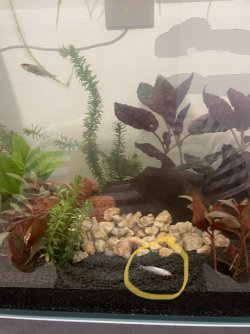Hi all,
I’ve recently stocked my aquarium with a dozen(12) rummy nose tetras in a community planted tank. This is the first time I’m keeping them and did all the research and hours upon hours of youtube videos to understand how to take care of them.
It has been about 30 hours since I got them, and I’m now down to 5, with another one of them likely going soon.
I got them from a local fish store which I trust and have bought from before, they take care of their fish well and I have never had any issues aside from one time that one of my betta’s came with/got ich.
I’ve seen with the ones that have passed that they all kept losing balance, only one of their side(arm) fins were flapping and constantly swimming on their side or upside down. Eventually they would land on a plant leaf or substrate and continued breathing until they eventually stopped and lost their colour. Most had bloated/big bellies, with 2 of them that have passed having normal sized bellies. Which I suspect with the online readings is a swim bladder issue.
I acclimated all the fish for roughly an hour an a half, first by floating the bag for 20 mins then slowly adding water bottlecap by bottlecap into their bag.
All the other fish in the tank, which I got on the same day, 2 Black Mollies and 4 Julii Corydoras seem fine, swimming happily and exploring and eating fine. Also to point out that none of the rummy nose tetra have eaten since I got them. Have tried micro pellets, flakes, live baby brine shrimp and live moina (water fleas/kutu air), they dont seem to be interested at all. The food all end up either sinking to the bottom where the corys eat them or stay floating where the mollies eat them.
So I have no clue what’s going on and can’t find much answers to this issue. All of them have their red noses when the balance loss thing happened. I’ve attached some pictures of the fish that is currently experiencing this. The fish circled in yellow is the same fish in all the pictures.
Current tank setup as below, I am using test strips so there are ranges in some of the chemical readings.
10.2 gallon tank (60cmx28cmx23cm), have been cycled for over 2 months with fancy guppies previously stocked.
Water changes previously once a week, 30%
Ammonia: 0
NO2: 0
NO3: Between 10-25
CL2: 0
TCL: 0
GH: Between 25-50
KH: Between 0-40
pH: Between 6.4-6.8
Temperature: 26 Degrees Celcius
Using API Ammonia test kit & Yee 7-in-1 Aquarium test strips to test the water.
If anyone has any idea what is wrong with them do let me know, kinda tired of burying a fish in my garden every hour.
Thanks!
I’ve recently stocked my aquarium with a dozen(12) rummy nose tetras in a community planted tank. This is the first time I’m keeping them and did all the research and hours upon hours of youtube videos to understand how to take care of them.
It has been about 30 hours since I got them, and I’m now down to 5, with another one of them likely going soon.
I got them from a local fish store which I trust and have bought from before, they take care of their fish well and I have never had any issues aside from one time that one of my betta’s came with/got ich.
I’ve seen with the ones that have passed that they all kept losing balance, only one of their side(arm) fins were flapping and constantly swimming on their side or upside down. Eventually they would land on a plant leaf or substrate and continued breathing until they eventually stopped and lost their colour. Most had bloated/big bellies, with 2 of them that have passed having normal sized bellies. Which I suspect with the online readings is a swim bladder issue.
I acclimated all the fish for roughly an hour an a half, first by floating the bag for 20 mins then slowly adding water bottlecap by bottlecap into their bag.
All the other fish in the tank, which I got on the same day, 2 Black Mollies and 4 Julii Corydoras seem fine, swimming happily and exploring and eating fine. Also to point out that none of the rummy nose tetra have eaten since I got them. Have tried micro pellets, flakes, live baby brine shrimp and live moina (water fleas/kutu air), they dont seem to be interested at all. The food all end up either sinking to the bottom where the corys eat them or stay floating where the mollies eat them.
So I have no clue what’s going on and can’t find much answers to this issue. All of them have their red noses when the balance loss thing happened. I’ve attached some pictures of the fish that is currently experiencing this. The fish circled in yellow is the same fish in all the pictures.
Current tank setup as below, I am using test strips so there are ranges in some of the chemical readings.
10.2 gallon tank (60cmx28cmx23cm), have been cycled for over 2 months with fancy guppies previously stocked.
Water changes previously once a week, 30%
Ammonia: 0
NO2: 0
NO3: Between 10-25
CL2: 0
TCL: 0
GH: Between 25-50
KH: Between 0-40
pH: Between 6.4-6.8
Temperature: 26 Degrees Celcius
Using API Ammonia test kit & Yee 7-in-1 Aquarium test strips to test the water.
If anyone has any idea what is wrong with them do let me know, kinda tired of burying a fish in my garden every hour.
Thanks!
Attachments
-
 16392BCB-DD75-4097-8726-FDE5088AD226.jpeg193.5 KB · Views: 74
16392BCB-DD75-4097-8726-FDE5088AD226.jpeg193.5 KB · Views: 74 -
 6D582B20-831E-44F1-B556-A3CA9B225EE9.jpeg201 KB · Views: 54
6D582B20-831E-44F1-B556-A3CA9B225EE9.jpeg201 KB · Views: 54 -
 75A44951-78C8-4E2C-BF87-5BD6D3619D48.jpeg209.8 KB · Views: 58
75A44951-78C8-4E2C-BF87-5BD6D3619D48.jpeg209.8 KB · Views: 58 -
 EC0BC5C3-3298-45A0-B0E3-510959BFD0E1.jpeg265 KB · Views: 61
EC0BC5C3-3298-45A0-B0E3-510959BFD0E1.jpeg265 KB · Views: 61 -
 30092AFD-9E5F-429E-BBDA-2C487AE5DD35.jpeg260.4 KB · Views: 55
30092AFD-9E5F-429E-BBDA-2C487AE5DD35.jpeg260.4 KB · Views: 55 -
 D973F4BC-834C-4538-A7E4-4182A96CDC4C.jpeg266.2 KB · Views: 50
D973F4BC-834C-4538-A7E4-4182A96CDC4C.jpeg266.2 KB · Views: 50 -
 49FE391A-A6E0-4463-8A63-41F72F1886F4.jpeg251.5 KB · Views: 53
49FE391A-A6E0-4463-8A63-41F72F1886F4.jpeg251.5 KB · Views: 53 -
 0E367BBB-8AB5-4CCF-85EF-F9DB951E3262.jpeg260.3 KB · Views: 66
0E367BBB-8AB5-4CCF-85EF-F9DB951E3262.jpeg260.3 KB · Views: 66 -
 91540F7C-63F0-4321-8335-F917F143F9E0.jpeg240.7 KB · Views: 56
91540F7C-63F0-4321-8335-F917F143F9E0.jpeg240.7 KB · Views: 56
Last edited:


